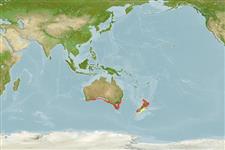>
Gadiformes (Cods) >
Moridae (Morid cods)
Etymology: Pseudophycis: Greek, pseudes = false + Greek, phykon = seaweed; because of the habit of living among them (Ref. 45335).
More on author: Richardson.
Environment: milieu / climate zone / depth range / distribution range
Ecologia
marino demersale; distribuzione batimetrica 0 - 220 m. Temperate; 33°S - 48°S, 112°E - 180°E (Ref. 1371)
Southwest Pacific: New Zealand, New South Wales to Western Australia, including Tasmania, less common to the west.
Size / Peso / Age
Maturity: Lm ? range ? - ? cm
Max length : 25.0 cm TL maschio/sesso non determinato; (Ref. 1371)
Spine dorsali (totale) : 0; Spine anali: 0. Pyloric caeca 6 to 8. Color is brown to pink-brown, becoming lighter ventrally; dorsal, anal, and caudal fins dark-edged.
Found over hard bottom. Rarely seen during the day. Swims close to the bottom at night.
Life cycle and mating behavior
Maturità | Riproduzione | Deposizione | Uova | Fecundity | Larve
Cohen, D.M., T. Inada, T. Iwamoto and N. Scialabba, 1990. FAO species catalogue. Vol. 10. Gadiform fishes of the world (Order Gadiformes). An annotated and illustrated catalogue of cods, hakes, grenadiers and other gadiform fishes known to date. FAO Fish. Synop. 125(10). Rome: FAO. 442 p. (Ref. 1371)
IUCN Red List Status (Ref. 130435: Version 2024-1)
Threat to humans
Harmless
Human uses
Pesca: pesca di sussistenza
Strumenti
Special reports
Download XML
Fonti Internet
Estimates based on models
Preferred temperature (Ref.
123201): 14 - 18.2, mean 15.5 °C (based on 160 cells).
Phylogenetic diversity index (Ref.
82804): PD
50 = 0.6250 [Uniqueness, from 0.5 = low to 2.0 = high].
Bayesian length-weight: a=0.00550 (0.00326 - 0.00928), b=3.13 (2.98 - 3.28), in cm total length, based on LWR estimates for this species & (Sub)family-body (Ref.
93245).
Trophic level (Ref.
69278): 3.5 ±0.5 se; based on size and trophs of closest relatives
Resilienza (Ref.
120179): Medio, tempo minimo di raddoppiamento della popolazione 1.4 - 4.4 anni (Preliminary K or Fecundity.).
Fishing Vulnerability (Ref.
59153): Low vulnerability (15 of 100).
Nutrients (Ref.
124155): Calcium = 17.7 [7.3, 36.7] mg/100g; Iron = 0.188 [0.094, 0.357] mg/100g; Protein = 18.9 [16.6, 21.2] %; Omega3 = 0.27 [0.13, 0.55] g/100g; Selenium = 8.83 [3.61, 20.87] μg/100g; VitaminA = 84.5 [19.3, 337.9] μg/100g; Zinc = 0.586 [0.367, 0.963] mg/100g (wet weight);
